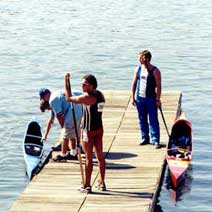Dagnis Vinogradovs is the lone paddler on the Latvian Olympic team heading for Athens. Vinogradovs, or “Vīnoga” as he is nicknamed, made the cut in May with a sixth-place finish in the European sprint canoe and kayak qualifications in Poznan, Poland. In Athens, he will race solo canoe (C-1) in the 500- and 1,000-metre competitions.
The 23-year-old athlete from Limbaži, a student at the Academy of Sports Education in Latvia, has been paddling for almost 10 years. He competed in several European and World junior championships before breaking into the adult circuit in 2002. During the 33rd International Canoe Federation’s Flatwater World Championships held in September in Gainesville, Ga., in the United States, Vinogradovs finished fourth in the B Final for the C-1 1,000-metre race. And on July 24 he placed first in the C-1 1,000-metre race in the European Under 23 (U-23) Championships in Poland.
“It is difficult to predict how well Dagnis will do at Athens,” said Viktors Zujevs, an assistant coach at the Latvian national paddling centre in Limbaži. “Dagnis is still young and inconsistent. He needs to mature in a sport where paddlers often compete well into their thirties.
“He has a lot of promise,” Zujevs continued. “A couple of years ago he beat world champion German paddler Andreas Ditmer in a race. On other occasions he has missed the finals. Dagnis could bring home a medal from Athens or just as easily end up empty-handed.”
Vinogradovs said he is mentally ready for the Olympics.
“Even though these will be my first Olympic games,” he said in an e-mail. “I don’t feel that they will be any different from the last World Championships or European Championships because there, too, it was a battle for life and death.”
To relax after the long and grueling hours spent training, Vinogradovs is trying his hand at fishing and just finished reading a crime novel.
In European countries like Germany, Hungary and Poland, sprint canoeing and kayaking is a huge spectator sport. Crowds of up to 50,000 attend international competitions in Hungary and ranked paddlers are national celebrities. While Canadian paddlers, and particularly women, have brought home medals, the sport is relatively unknown in Canada and even more so in the United States. It is often confused with whitewater paddling, which is a separate sport and Olympic discipline.
Olympic sprint canoe and kayak events include the 500- and 1,000-metre races, with the 200-metre added in national and world championships. Canoers and kayakers, or C-boaters and K-boaters as they are often called, race in solo (C-1 and K-1), two-person (C-2 and K-2) or four-person (C-4 and K-4) boats. The four-person canoe is not raced in the Olympics.
Sprint canoes and kayaks are built for speed. They are sleek and light. The K-1 or solo kayak weighs only 12 kilograms, while the C-1 or solo canoe in which inogradovs races weighs 16 kilograms. Even the K-4 is relatively light at 30 kilograms. Expect to see top Olympic times for 1,000-metre races of around 3’50” for the C-1 and 3’30” for the K-1.
Canoeing differs from kayaking. A canoer is on one knee and paddles to one side. A kayaker sits and paddles on both sides with a double bladed paddle. The canoe has no steering mechanism and is controlled through paddling technique, but a kayak has a rudder with foot controls.
Both have open cockpits. If a paddler tips, they get thrown out into the water and the race is over for them. Forget the Eskimo roll in sprint kayaking or canoeing.
Both men and women kayak, but only men canoe at the Olympics and most international competitions. While women canoers are common in Canada and only recently have been accepted in the United States, they are prevented from competing internationally by entrenched chauvinistic attitudes, particularly in the national federations of the big European paddling powers.
Sprint canoe and kayak traditions in Latvia date back to the Soviet occupation. Paddlers from Latvia who competed internationally under the Soviet banner include Aleksandrs Afdejevs, Juris Runcis and Sergejs Zaļupe. A former Soviet era world champion kayaker is Vilnis Baltiņš, the current president of the Latvian Olympic Committee. The most successful Olympic canoer from Latvia is Ivans Klementjevs, who won a gold for the Soviet Union in Seoul in 1998 and then followed with medals for Latvia—a silver in Barcelona in 1992 and a bronze in Atlanta in 1996.
About 500 canoers and kayakers are active in Latvia today, and of those 20-30 are competitive internationally. Clubs are found in Rīga, Ventspils, Jelgava, Saldus (Brocēni), Limbaži and Jūrmala. The national team is based and trains in Limbaži, 80 kilometres northeast of Rīga in Vidzeme province. Genadijs Zujevs is head coach and he will accompany Vinogradovs to Athens.
Vinogradovs is scheduled to compete Aug. 23-28 at the Schinias Olympic Rowing and Canoeing Centre east of Athens near Marathon.
K-4 kayak crew hopefuls Ronalds Stālmanis, Mārtiņš Upītis, Kristaps Zaļupe un Arnis Lazdinieks did not qualify for this summer’s games despite posting good results in international competitions the last two years.

Dagnis Vinogradovs (center) waits while his canoe is weighed in after the B final of the 2003 World Championships in Gainesville, Ga. (Photo by Viesturs Zariņš)
© 1995-2024 Latvians Online
Please contact us for editorial queries, or for permission to republish material. Disclaimer: The content of Web sites to which Latvians Online provides links does not necessarily reflect the opinion of Latvians Online, its staff or its sponsors.




